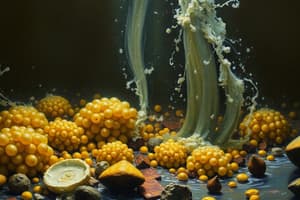Podcast
Questions and Answers
What is the primary nitrogenous waste produced by aquatic animals?
What is the primary nitrogenous waste produced by aquatic animals?
- Ammonia (correct)
- Uric acid
- Urea
- Creatinine
Which nitrogenous waste is considered less toxic than ammonia?
Which nitrogenous waste is considered less toxic than ammonia?
- Uric acid
- Urea (correct)
- Ammonium ions
- Creatinine
What term describes animals that excrete urea?
What term describes animals that excrete urea?
- Ammonotelic
- Uricotelic
- Creatinotelic
- Ureotelic (correct)
What is the key factor that affects the type of nitrogenous waste an animal excretes?
What is the key factor that affects the type of nitrogenous waste an animal excretes?
Which nitrogenous waste is produced as an oxidative metabolic product of purines?
Which nitrogenous waste is produced as an oxidative metabolic product of purines?
What is the chemical formula for urea?
What is the chemical formula for urea?
Ammonia is converted into which nitrogenous waste in terrestrial animals?
Ammonia is converted into which nitrogenous waste in terrestrial animals?
What is the primary purpose of dialysis?
What is the primary purpose of dialysis?
What is hemodialysis commonly referred to as?
What is hemodialysis commonly referred to as?
Which type of dialysis is designed for critical patients unable to tolerate frequent procedures?
Which type of dialysis is designed for critical patients unable to tolerate frequent procedures?
What role does the peritoneum play in peritoneal dialysis?
What role does the peritoneum play in peritoneal dialysis?
Which of the following is a common complication of hemodialysis?
Which of the following is a common complication of hemodialysis?
What is the main function of nephrons in the kidneys?
What is the main function of nephrons in the kidneys?
Which type of nephron has a longer loop of Henle?
Which type of nephron has a longer loop of Henle?
What is the structure surrounding the glomerulus called?
What is the structure surrounding the glomerulus called?
What is the primary reason for high pressure in the glomerulus?
What is the primary reason for high pressure in the glomerulus?
Which cells are wrapped around the glomerular capillaries?
Which cells are wrapped around the glomerular capillaries?
What prevents large molecules from passing through the glomerular capillaries?
What prevents large molecules from passing through the glomerular capillaries?
Which part of the nephron is referred to as the malpighian body?
Which part of the nephron is referred to as the malpighian body?
Which of the following is NOT a component of the nephron?
Which of the following is NOT a component of the nephron?
What primarily facilitates ultrafiltration in the glomerulus?
What primarily facilitates ultrafiltration in the glomerulus?
What is the primary cause of urinary tract infections?
What is the primary cause of urinary tract infections?
Which symptom is most commonly associated with pyelonephritis?
Which symptom is most commonly associated with pyelonephritis?
What can high levels of calcium in urine lead to?
What can high levels of calcium in urine lead to?
Cystitis is primarily associated with which bacterium?
Cystitis is primarily associated with which bacterium?
What is a common symptom of urethritis?
What is a common symptom of urethritis?
What can cause urine to become too acidic or basic?
What can cause urine to become too acidic or basic?
Which of the following is NOT a typical symptom of cystitis?
Which of the following is NOT a typical symptom of cystitis?
Hyperoxaluria refers to which condition?
Hyperoxaluria refers to which condition?
What feeling is often experienced during cystitis?
What feeling is often experienced during cystitis?
What allows for passive diffusion in peritubular capillaries?
What allows for passive diffusion in peritubular capillaries?
Which substances are absorbed actively in the renal tubules?
Which substances are absorbed actively in the renal tubules?
What is the primary function of the counter current mechanism?
What is the primary function of the counter current mechanism?
Which part of the nephron is primarily responsible for tubular secretion?
Which part of the nephron is primarily responsible for tubular secretion?
What effect does aldosterone have on the kidneys?
What effect does aldosterone have on the kidneys?
What does the ascending limb of the loop of Henle primarily absorb?
What does the ascending limb of the loop of Henle primarily absorb?
How does the descending limb of the loop of Henle function?
How does the descending limb of the loop of Henle function?
What is the role of urea in the renal medulla?
What is the role of urea in the renal medulla?
What is the process called when blood from peritubular capillaries retains solutes to maintain medullary concentration gradients?
What is the process called when blood from peritubular capillaries retains solutes to maintain medullary concentration gradients?
Which hormone facilitates the movement of water in the kidneys?
Which hormone facilitates the movement of water in the kidneys?
What effect does the counter current multiplier have on the renal medulla?
What effect does the counter current multiplier have on the renal medulla?
Flashcards
Ammonia (NH3)
Ammonia (NH3)
Ammonia is a highly toxic waste product produced by the breakdown of nitrogenous compounds. It's soluble in water and raises pH.
Urea (CO(NH2)2)
Urea (CO(NH2)2)
Urea is a less toxic waste product produced by mammals, amphibians, and some fish. It's formed from ammonia and carbon dioxide in the liver.
Uric acid
Uric acid
Uric acid is a waste product produced by the breakdown of purines, found in nucleic acids.
Ammonotelic
Ammonotelic
Signup and view all the flashcards
Ureotelic
Ureotelic
Signup and view all the flashcards
Nitrogenous Wastes
Nitrogenous Wastes
Signup and view all the flashcards
Factors affecting nitrogenous waste type
Factors affecting nitrogenous waste type
Signup and view all the flashcards
What is tubular secretion?
What is tubular secretion?
Signup and view all the flashcards
What is the Countercurrent Mechanism?
What is the Countercurrent Mechanism?
Signup and view all the flashcards
Why is the medulla hypertonic?
Why is the medulla hypertonic?
Signup and view all the flashcards
What happens to water in the descending limb?
What happens to water in the descending limb?
Signup and view all the flashcards
How does Aldosterone impact the Countercurrent Mechanism?
How does Aldosterone impact the Countercurrent Mechanism?
Signup and view all the flashcards
How does ADH affect urine concentration?
How does ADH affect urine concentration?
Signup and view all the flashcards
How does Urea contribute to the hypertonic medulla?
How does Urea contribute to the hypertonic medulla?
Signup and view all the flashcards
What is the Countercurrent multiplier?
What is the Countercurrent multiplier?
Signup and view all the flashcards
What is the Countercurrent exchange?
What is the Countercurrent exchange?
Signup and view all the flashcards
What is the role of the peritubular capillaries in the Countercurrent exchange?
What is the role of the peritubular capillaries in the Countercurrent exchange?
Signup and view all the flashcards
Dialysis
Dialysis
Signup and view all the flashcards
Hemodialysis
Hemodialysis
Signup and view all the flashcards
AV Fistula
AV Fistula
Signup and view all the flashcards
Peritoneal dialysis
Peritoneal dialysis
Signup and view all the flashcards
Continuous Renal Replacement Therapy (CRRT)
Continuous Renal Replacement Therapy (CRRT)
Signup and view all the flashcards
Water Reabsorption in the Kidneys
Water Reabsorption in the Kidneys
Signup and view all the flashcards
Solute Reabsorption and Secretion in the Kidneys
Solute Reabsorption and Secretion in the Kidneys
Signup and view all the flashcards
Peritubular Capillaries (Vasa Recta)
Peritubular Capillaries (Vasa Recta)
Signup and view all the flashcards
Pyelonephritis (Kidney Infection)
Pyelonephritis (Kidney Infection)
Signup and view all the flashcards
Urethritis (Urethra Infection)
Urethritis (Urethra Infection)
Signup and view all the flashcards
Cystitis (Bladder Infection)
Cystitis (Bladder Infection)
Signup and view all the flashcards
Kidney Stones
Kidney Stones
Signup and view all the flashcards
Hypercalciuria
Hypercalciuria
Signup and view all the flashcards
Hyperoxaluria
Hyperoxaluria
Signup and view all the flashcards
Kidney Stone Formation
Kidney Stone Formation
Signup and view all the flashcards
Nephron
Nephron
Signup and view all the flashcards
Glomerulus
Glomerulus
Signup and view all the flashcards
Bowman's capsule
Bowman's capsule
Signup and view all the flashcards
Glomerular filtration pressure
Glomerular filtration pressure
Signup and view all the flashcards
Podocytes
Podocytes
Signup and view all the flashcards
Renal tubule
Renal tubule
Signup and view all the flashcards
Filtration
Filtration
Signup and view all the flashcards
Ultrafiltration
Ultrafiltration
Signup and view all the flashcards
Juxtamedullary nephrons
Juxtamedullary nephrons
Signup and view all the flashcards
Study Notes
Homeostasis
- Homeostasis is a self-regulating process maintaining stability in biological systems while adapting to changes.
- It's crucial for the continuity of life, ensuring consistent body functions in response to the environment.
- Organisms in terrestrial and aquatic environments adapt physically and physiologically to variable conditions.
- Maintaining internal body conditions within particular limits is essential.
- The body's physical environment (fluids, tissues, organs, etc.) is well integrated and regulated by endocrine and nervous systems.
- These systems coordinate functions like osmoregulation, excretion, and thermoregulation.
Elements of Homeostasis
- Homeostatic mechanisms are based on a feedback system, maintaining normal conditions.
- Feedback mechanisms involve receptors, a control center (CNS), and effectors.
- Receptors detect internal and external changes and transmit information to the CNS.
- The CNS processes this information and commands effector organs to restore normal conditions.
Feedback Systems
- Feedback is a response within a biological system that influences its activity or productivity.
- There are two types of feedback: positive and negative.
- Positive feedback amplifies a change in a system.
- Negative feedback suppresses a change in a system, bringing it back to a stable state.
Osmoregulation
- Organisms maintain appropriate water and mineral levels for vital functions.
- Osmoregulation is particularly important for organisms living in different environments.
- Osmoconformers maintain internal solute concentrations similar to their external environment.
- Osmoregulators maintain a constant internal osmotic state.
- Freshwater animals face osmotic incursion of water, while marine animals must obtain water and excrete excessive salts.
- Terrestrial animals need mechanisms to conserve water in hot environments.
Excretion
- Excretion is the process of removing metabolic wastes from the body.
- It's crucial for maintaining homeostasis, regulating osmotic pressure, and maintaining acid-base balance through handling various compounds like ammonia, urea, uric acid, and creatinine.
- Different animals produce different nitrogenous wastes based on habitat (ammonia from aquatic organisms, urea from terrestrial mammals, uric acid from birds and reptiles).
Urinary System of Man
- The urinary system is composed of kidneys, ureters, bladder, and urethra to remove waste.
- Kidneys filter blood, remove wastes, and maintain electrolyte and acid-base balance.
- Blood filtration in the kidneys leads to urine formation.
- Urine is stored in the bladder and expelled through the urethra.
Kidney transplant
- Kidney transplant is a surgical procedure where a healthy kidney from a donor is placed in a recipient with kidney failure.
- Matching blood types and biochemical characteristics of the donor and recipient are crucial.
- Immunosuppressant drugs are administered to prevent the recipient's immune system from rejecting the transplanted kidney.
Thermoregulation
- Thermoregulation is a homeostatic mechanism to maintain internal body temperature in a range suitable to physiological processes.
- Ectotherms (poikilotherms) obtain heat from their environment.
- Endotherms (homeotherms) regulate their internal body temperature through metabolic processes.
- Humans, being endotherms, maintain a constant body temperature through physiological and behavioral means.
Studying That Suits You
Use AI to generate personalized quizzes and flashcards to suit your learning preferences.
Related Documents
Description
Test your knowledge on nitrogenous waste production in animals. This quiz covers the different types of nitrogenous waste, their toxicity levels, and related concepts in dialysis. Enhance your understanding of animal physiology and waste management processes.





